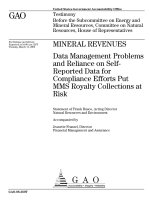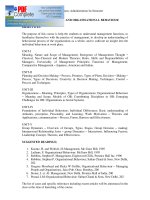Chap001 international management globalization and international lingages
Bạn đang xem bản rút gọn của tài liệu. Xem và tải ngay bản đầy đủ của tài liệu tại đây (478.69 KB, 38 trang )
chapter one
Globalization and
International Linkages
McGraw-Hill/Irwin
Chapter 1: Globalization and
International Linkages
• The specific objectives of this chapter are:
1. ASSESS the implications of globalization for
countries, industries, firms, and communities.
2. REVIEW the major trends in global and
regional integration.
3. EXAMINE the changing balance of global
economic power and trade and investment
flows among countries.
4. ANALYZE the major economic systems and recent
developments among countries that reflect those
systems.
1-2
International Management
• International management process:
– Applying management concepts and techniques in
a multinational environment;
– Adapting management practices to different
economic, political, and cultural environments.
• Multinational corporation (MNC):
–
–
–
Operations in more than one country
International sales
Nationality mix of managers and owners
1-3
The World’s Top Nonfinancial MNCs from Developed
Countries
(ranked by foreign assets, 2004)
1-4
The World’s Top Nonfinancial MNCs from Developing
Countries
(ranked by foreign assets, 2004)
1-5
Globalization and Internationalization
• Globalization: the process of integration
among countries around the world with a
vision of a single market entity:
Social Economic Political Technological Cultural
• Worldwide trend of the economies of the world
becoming borderless and interlinked.
• Not all economies are participating or benefiting
equally in the process.
• Important forces are driving globalization.
• It is also important to look at classifications of the
world’s economies.
1-6
Globalization and Internationalization
• Internationalization: the process of a
business crossing national and cultural
borders.
• International Business:
– An organization operating in more than one
country.
– Organizations from different countries
trading across national boundaries.
1-7
Transnational business:
– A business conducting its activities in a
large range of countries across national
boundaries,
– with varying degrees of co-ordination,
integration and
– local differentiation of strategy and
operations, depending on market and
business conditions.
1-8
Globalization: Pros and Cons
• Benefits of Globalization:
wealth, jobs, technology, lower prices.
• Criticisms of Globalization:
off-shoring of business service jobs to lowerwage countries;
growing trade deficits;
slow wage growth;
environmental and social impacts.
1-9
Global and Regional Integration:
• Global Agreements:
World Trade Organization (WTO)
(General Agreement on Tariffs and Trade
(GATT))
• Regional Agreements:
North American Free Trade Agreement (NAFTA)
U.S.-Central American Free Trade Agreement
(CAFTA)
European Union (EU)
Association of Southeast Asian Nations (ASEAN)
Free Trade Agreement of the Americas (FTAA)
1-10
International Economic Power in
the Global Economy:
Shifting landscape due to:
• Economic integration
• Economic potential of emerging
markets
1-11
The World’s Largest Economies 2005 and 2020 (Projected) Measured
by GDP at Market Exchange Rates:
1-12
The World’s Largest Economies 2005 and 2020 (Projected) Measured
by GDP at Purchasing Power Parity (ppp)
1-13
Most Populous Countries in 1980, 2000,
and 2050 (Projected):
1-14
Trends in International
Investments and Trade:
• International Investments:
80% from developed countries
Foreign direct investment (FDI)
Growing at healthy rate
Outpacing domestic growth in most countries
• International Trade:
Over ½ of world trade accounted for by United
States, European Union and Japan
Increased substantially over last two decades
1-15
Trade Flows Among World Regions, 2005 (in billions of dollars or
percent)
1-16
World Foreign Direct Investment Inflows
(in millions of dollars):
1-17
World Foreign Direct Investment Outflows
(in millions of dollars):
1-18
Economic Systems of the World:
•
•
•
Market Economy
Command Economy
Mixed Economy
1-19
Economic Systems of the world
• Market Economy
– Private enterprise reserve the right to own
property and decide on what and how much
to produce.
– Contains the least restriction in the
allocation of resources
– A general balance between supply and
demand
– Competition is encouraged
– Government may limit monopolies, or unfair
practices.
1-20
Economic Systems of the world
• Command Economy
– Compared to Monopoly where the
government has explicit control over the
price and supply.
– The control is based on theoretical need of
the population and might be distorted
– Businesses are owned by the state to
ensure investment in the best interests of
the society.
– Government subsidies provide security to
organizations.
1-21
Economic Systems of the world
• Mixed Economy
– Combination of market and command
economy.
– Some sectors are private while others are
controlled and owned by the government.
– Allow for competition while enable to
provide assistance to individuals or
companies
– Nationalization of major resources.
– What are some of the issues with this
1-22
Economic Performance
by Major World Region:
• North America
• South America
• Europe (EU, Central and Eastern
Europe)
• Asia (Japan, China, emerging markets of
Asia)
• Other developing and emerging
countries (India, Middle East, Central
Asia, Africa)
1-23
Economic Performance:
North America
• North America:
– Free market base economy in region
– Combined purchasing power of U.S., Canada and Mexico
approaches $12 trillion in purchasing power
– Foreign MNC’s find U.S. to be a lucrative market
• United States:
• Foreign MNC’s find U.S. a lucrative expansion
market
• Foreign firms welcomed as investors in U.S.
market
• U.S. firms hold market dominance in many
European markets; gaining market share in Asia
1-24
Economic Performance:
North America (continued):
Canada:
• U.S.’s largest trading partner
• Most of the largest foreign-owned Canadian
companies are totally or heavily U.S.-owned
• Legal and business environment in Canada is
similar to that in U.S.
Mexico:
• Strongest Latin American economy
• Very strong maquiladora industry
• Trade with both Europe and Asia has increased
• Now competitive with Asia for the U.S. market
1-25









